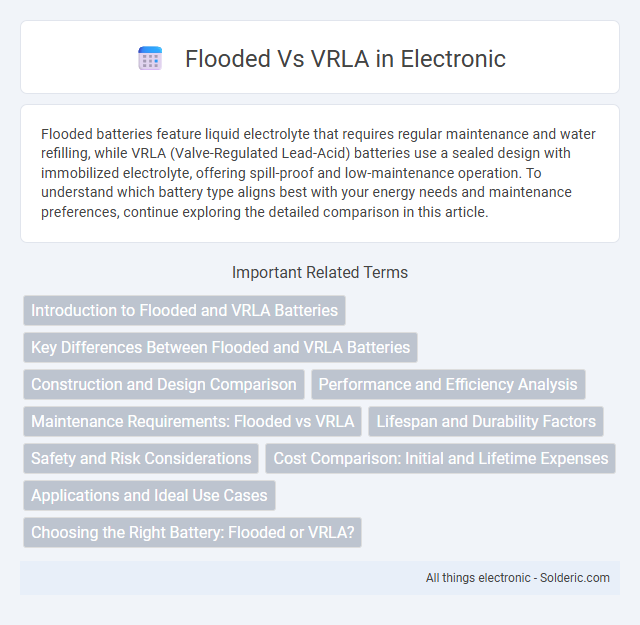Flooded batteries feature liquid electrolyte that requires regular maintenance and water refilling, while VRLA (Valve-Regulated Lead-Acid) batteries use a sealed design with immobilized electrolyte, offering spill-proof and low-maintenance operation. To understand which battery type aligns best with your energy needs and maintenance preferences, continue exploring the detailed comparison in this article.
Comparison Table
| Feature | Flooded Battery | VRLA Battery |
|---|---|---|
| Construction | Lead plates submerged in liquid electrolyte | Sealed lead acid with Absorbent Glass Mat (AGM) or gel |
| Maintenance | Requires regular water refilling and monitoring | Maintenance-free, no water refilling necessary |
| Gas Emission | Releases hydrogen and oxygen gases during charging | Valve-regulated, minimal gas release under normal conditions |
| Orientation | Must remain upright to prevent electrolyte spillage | Can be installed in various positions safely |
| Lifespan | Typically 3-5 years with proper maintenance | Generally 4-7 years, depending on usage and type |
| Cost | Lower initial cost | Higher initial cost |
| Applications | Backup power, automotive, industrial use | Telecom, UPS, emergency power, mobility devices |
| Safety | Requires ventilation due to gas emission | Safer, sealed design reduces risk of leaks and explosions |
Introduction to Flooded and VRLA Batteries
Flooded batteries, also known as wet cell batteries, contain liquid electrolyte that requires regular maintenance to ensure optimal performance and longevity. Valve-Regulated Lead-Acid (VRLA) batteries, including Absorbent Glass Mat (AGM) and Gel varieties, are sealed and maintenance-free, designed to prevent electrolyte spillage while providing reliable energy storage in various applications. Both battery types use lead-acid chemistry but differ significantly in construction, maintenance needs, and suitability for specific environments.
Key Differences Between Flooded and VRLA Batteries
Flooded batteries have liquid electrolyte that requires regular maintenance such as water refilling, while VRLA (Valve-Regulated Lead-Acid) batteries are sealed and maintenance-free, making them more convenient for daily use. Flooded batteries generally offer a longer lifespan and better tolerance to overcharging but are heavier and prone to spillage, unlike the compact and safer VRLA batteries designed for sealed environments. Your choice between these batteries should consider factors like installation site, maintenance capacity, and performance needs.
Construction and Design Comparison
Flooded batteries feature a liquid electrolyte that submerges the lead plates, allowing for efficient heat dissipation and easier maintenance through water refilling. VRLA (Valve Regulated Lead Acid) batteries use a sealed design with a gel or absorbed glass mat (AGM) electrolyte, preventing spillage and enabling installation in various orientations without leakage risks. Your choice depends on maintenance preferences and application requirements, with flooded batteries requiring regular monitoring and VRLA offering a more compact, low-maintenance solution.
Performance and Efficiency Analysis
Flooded batteries offer superior cooling and longer cycle life through their liquid electrolyte design, but require regular maintenance and ventilation. VRLA (Valve-Regulated Lead-Acid) batteries provide sealed, maintenance-free operation with lower gas emissions and better suitability for sealed environments, yet may have a shorter lifespan under deep discharge conditions. Your choice between Flooded and VRLA batteries depends on balancing performance needs with operational efficiency and maintenance capabilities.
Maintenance Requirements: Flooded vs VRLA
Flooded lead-acid batteries require regular maintenance including checking electrolyte levels, topping up with distilled water, and equalizing charges to prevent sulfation. VRLA (Valve-Regulated Lead-Acid) batteries are maintenance-free with sealed designs that prevent electrolyte loss, eliminating the need for water refills and reducing the risk of acid spills. The lower maintenance demands of VRLA batteries make them ideal for applications where accessibility and upkeep are limited.
Lifespan and Durability Factors
Flooded batteries typically offer a longer lifespan of 5 to 10 years due to their robust design and ability to tolerate deep discharges and high temperatures, but require regular maintenance to ensure durability. VRLA (Valve-Regulated Lead-Acid) batteries usually last between 3 to 7 years, benefiting from sealed construction that prevents electrolyte loss and reduces corrosion, enhancing reliability in sealed environments. Temperature stability, depth of discharge cycles, and maintenance frequency are critical durability factors influencing the lifespan differences between flooded and VRLA batteries.
Safety and Risk Considerations
Flooded lead-acid batteries offer effective ventilation but pose risks of acid spills and hydrogen gas buildup, requiring careful handling and maintenance. VRLA (Valve Regulated Lead Acid) batteries are sealed, reducing the hazard of acid leaks and minimizing gas emissions, which enhances safety in confined or indoor spaces. Proper installation and adherence to manufacturer guidelines are critical for both types to mitigate risks associated with overheating, short circuits, and electrolyte exposure.
Cost Comparison: Initial and Lifetime Expenses
Flooded lead-acid batteries generally have a lower initial cost compared to VRLA (Valve-Regulated Lead-Acid) batteries, making them a budget-friendly option for large-scale energy storage. However, their lifetime expenses tend to be higher due to frequent maintenance, electrolyte refilling, and shorter cycle life. VRLA batteries, although more expensive upfront, offer reduced maintenance costs and longer service life, leading to better total cost of ownership in applications requiring reliability and lower downtime.
Applications and Ideal Use Cases
Flooded batteries excel in heavy-duty industrial applications such as backup power for data centers, renewable energy storage, and large-scale grid support due to their high capacity and cost-effectiveness. VRLA (Valve Regulated Lead Acid) batteries are ideal for residential solar systems, uninterruptible power supplies (UPS), and telecommunications where maintenance-free operation and compact design are critical. Both battery types serve specific needs, but VRLA batteries are preferred in environments requiring sealed, vibration-resistant, and leak-free power sources.
Choosing the Right Battery: Flooded or VRLA?
Flooded batteries offer high durability and cost-effectiveness, making them ideal for applications with regular maintenance access, such as backup power and renewable energy systems. VRLA batteries, including AGM and gel types, provide maintenance-free operation and better safety features, suited for enclosed or hard-to-reach installations. Selecting the right battery depends on factors like budget, maintenance willingness, installation environment, and desired lifespan.
Flooded vs VRLA Infographic

 solderic.com
solderic.com